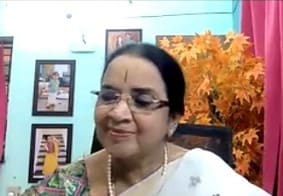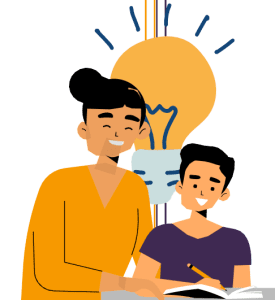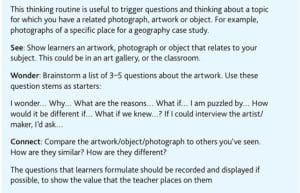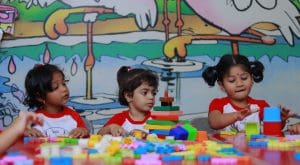Ms. Meenakshi Ramesh,
Director, Curriculum, Research and Development – Vels Group of Schools

“Electricity is not only present in a magnificent thunderstorm and dazzling lighting, but also in a lamp; so also, creativity exists not only where it creates great historical works, but also everywhere human imagination combines, changes, and creates anything new.”
– Lev Vygotsky
According to Ken Robinson “Creativity is the ability to generate new ideas and apply them in practice.”
In the course of our life, our perspectives keep evolving. These perspectives we develop often contribute to the choices we make, making us responsible to create our own lives. During this process, we develop an innate ability to discover our passions, likes, talents and are motivated to pursue the same. Schools play an important role in creating opportunities for students to develop their unique capacities for thought and action.
As educators, it is imperative that we understand the attributes that we can count as evident for creative teaching and learning
Creativity in Teaching pursuits can be identified when one is:
- Experimenting with new ideas
- Engaging in inquiry-based approach in learning (E.g.: PBL)
- Willing to explore and accept suggestions with constructive feedback
- Being highly resourceful
- Displaying imagination and flexibility in thought

Creativity in Learning pursuits can be identified when one:
- Welcomes a new challenge
- Meets the challenge Resourcefully, Creatively and Imaginatively
- Exhibits flexibility and adaptability in an unfamiliar situation
- Keenly applies new skills and techniques
Creative and resourceful teachers can even use household products like a pinch of turmeric powder as effective resource material from playschool to grade 12. (For a deeper understanding into using turmeric as a resource, click on the following link – https://youtu.be/M3VKpfuds0Y) Creativity is essential to development. We need to use innovative ideas and ways to ensure our learners become creative individuals.
To efficiently develop creative learners, we must gain a deeper understanding of the aspects of creativity. The Four C Model of Creativity (Dr. James C. Kaufman and Dr. Ronald Beghetto) categorizes creativity to nurture creativity in our learners.
The Big-C level of creativity
As the name suggests, this category holds the few people whose life’s work is accepted as ground-breaking innovation. The Big-C level includes an evaluation of one’s entire career and the entire body of work. They are highly creative people who have transformed their disciplines with their innovations.
E.g.: Einstein’s Theory of Relativity, Darwin’s Theory of Evolution, Picasso’s Guernica Art piece, Beethoven’s Symphony No.9 in D Minor, etc.
Those at the Big-C level will be remembered in the history books. It can even be said that Big C Creativity is out of reach for most of us. The Big C creators are themselves as extraordinary as their creations.
The Pro-C level of creativity
The creators at this level have invested time and effort to develop their craft. At this level, one can be creative at a professional level and in a professional venue. At this point, one would have had many years of deliberate practice and training. A good example is a child who showed great promise as a musician and pursued his interest to be trained to a professional level and now pursues his interest as a career.
The little-C level of creativity
With appropriate feedback, Little-c creators can create original and meaningful work that can be of value to others. They act with intelligence, flexibility, and novelty in their everyday life. These creators possess an eye for design and are often seen creating thematic works of art built over a period. For example, Photography exhibitions, stamp collectors, etc. These creators build their craft over years of practice and are heavily supported by the Internet infrastructure. Websites like YouTube, Instagram, Etsy, etc. have developed to become ecosystems that support the little-c creators.
The mini-C level of creativity
Creativity is inherent in learning. Any time one attempts a new task, there is a level of creativity involved. At the mini-c level of creativity, what one creates might not be revolutionary, but it is new and meaningful to them. As these are novel and personally meaningful experiences teachers and parents play a major role in nurturing mini-c creators. Most often mini-c creations may not be visible, but the learners must be accepted as creators when something new is the outcome.
Appropriately put by Vygotsky, “Any human act that gives rise to something new is referred to as creative art.”
Jean Piaget suggests that “To understand is to invent.” With this in mind, one can say, mini-c creativity is just like finding different ways to solve a math problem. Creative teachers must understand that using the constructivist approach in class for learners to form new connections is evidence of creative learners. We must also take into account that not all students can easily express their creativity. While new learning occurs, showcasing this new learning becomes a silent crutch. Using Visible Learning Techniques such as See, Think, Wonder provides structured avenues for students to display their creativity (new learning).


*Pic Courtesy: Harvard Project Zero – Artful thinking routines – See/ Think/ Wonder
Creativity must be viewed as an integral part of every subject. For example, Math offers endless possibilities of creativity in its patterns, reasoning, and results. Creative teaching and learning activities must include everyday activities to better understand concepts. The traditional Kolam is a great example. The simple art of adorning every home is an extension of patterns, a math concept. (Creative kolams – https://www.youtube.com/watch?v=nJ868k1_e-g)
While we understand creativity, we must also acknowledge the difference between Creativity and Innovation. Creativity and Innovations are often used interchangeably. However, creativity is at the heart of innovation and is an active process necessarily involved in innovation.
So, how then can teachers prioritize creativity to give way to innovation? Role modelling creative habits develop creative learners. Habits like curiosity, flexibility, sensitivity, intuitiveness, etc. must be displayed by the creative teacher. Visible learning activities, recommended by Project Zero must become a regular class activity.

Another important aspect of developing creative learners is to take QUESTIONING seriously. Teachers must create a culture of questioning in a class by simply appreciating all questions.
Some other pointers for creative teachers:
- Consider mistakes as learning opportunities
- Encourage learners to take meaningful risks
- Create opportunities for sensible and reasonable risks
- Provide sufficient time to ingrain concepts
- Use appropriate Scaffolding Techniques to create appropriate levels of challenge
- Provide ample time to learners to work out ideas properly
- Avoid jumping to conclusions while considering learner ideas
- Use Socratic questioning to trigger creativity
- Embed artful thinking routines into teaching and learning activities
- Give opportunities for reflection to assess creativity and innovation
It is essential that educators realize that nurturing creativity is an essential piece of the learning process. Furthermore, educators should recognize that creativity is a process that happens throughout our lifetime. We must recognize that a small child and a grown adult can both be creative. We need to recognize and find value in creativity at all levels for more reading refer http://www.pz.harvard.edu/thinking- routines#IntroducingExploringIdeas
Creating a culture of creativity in schools and classrooms is the need of the hour. Every child is born with a creative instinct. Imaginary play is a gateway into creating this culture. While the children indulge in imaginary play, they discover endless possibilities to learn something
new as they play. For example, we often witness children enjoy turning a cardboard box into a car/ spaceship or a simple roti dough can transform into a castle and so much more. Children have the magical ability to infuse life into toys. Engaging in imaginary play can improve vocabulary skills, problem-solving skills, socio-emotional skills apart from creating a culture of creativity.


*Free playtime prescribed by the Kindle Kids International Curriculum @ Vels International School
The curriculum followed by the school plays a major role in this endeavour. Broad-based and balanced curriculum like the Internationally acclaimed “Kindle Kids International Curriculum” can systematically aid in building a creative learning environment. The KKIC curriculum creates learning opportunities that motivate and aid the students to experience a range of subjects and activities integrated with arts and engages collaborative learning.
References:
- Lev Vygotsky, 1930/1967, cited in Smolucha, 1992, p. 54
- Cambridge Resources
- http://www.pz.harvard.edu/thinking-routines#IntroducingExploringIdeas
- Returning Creativity to the Classroom, Resources Section 1. Kaufman, J. C., & Beghetto, R. A. (2009).


